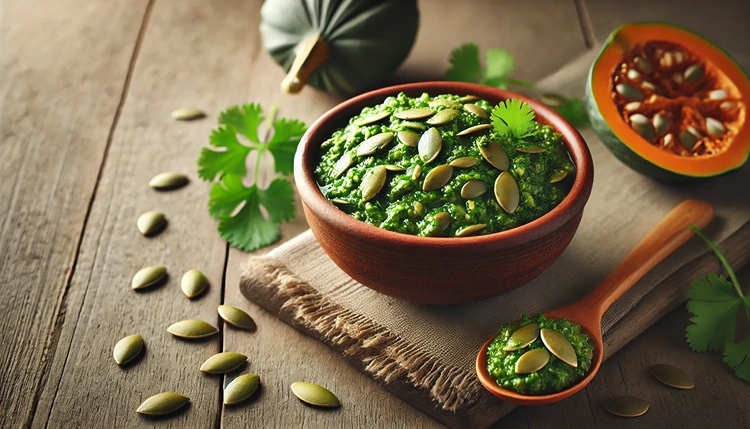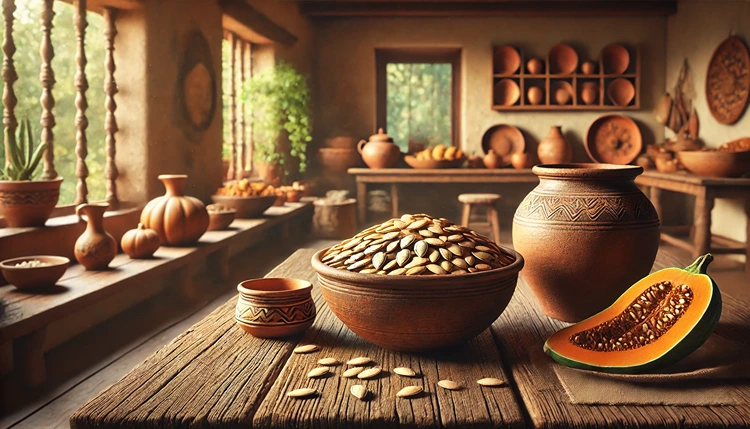When we think of superfoods today, pumpkin seeds often make the list. But long before the term ‘superfood’ existed, the Aztecs were already tapping into the nutritional power of these small seeds. In Aztec cuisine, pumpkin seeds, known as “pepitas,” were a staple, cherished not just for their flavor but for their incredible health benefits. From nutrient-rich meals to medicinal uses, pumpkin seeds played a pivotal role in the everyday life of the Aztec people.
In this article, we’ll explore the many ways pumpkin seeds were utilized in the Aztec diet and how they continue to influence Mexican cuisine today. By diving into the historical significance, nutritional value, and creative uses of pumpkin seeds, you’ll gain a better understanding of why these tiny seeds were considered a treasure in the ancient world.
Why Were Pumpkin Seeds So Important in the Aztec Diet?
The importance of pumpkin seeds in the Aztec diet can’t be overstated. For a culture that thrived on sustainability and making the most out of their resources, every part of the pumpkin plant was utilized. The seeds, in particular, were a crucial food source, packed with protein, healthy fats, and essential vitamins. They provided the necessary fuel to support the physical demands of Aztec society, from warriors to farmers.
Pepitas weren’t just a convenient snack; they were deeply rooted in Aztec traditions and rituals. In fact, they were often used as offerings to the gods during religious ceremonies, symbolizing fertility and life. Whether roasted and eaten on their own, ground into sauces, or mixed into various dishes, pumpkin seeds were a versatile and valuable part of daily life.
Rich Source of Nutrients
One of the main reasons pumpkin seeds held such importance was their dense nutritional profile. The Aztecs understood the value of nutrient-dense foods, and pepitas delivered on all fronts. Loaded with magnesium, zinc, and iron, they were vital in promoting good health, supporting energy levels, and boosting the immune system.
These tiny seeds are also a fantastic source of plant-based protein, something that was particularly valuable in the largely vegetarian Aztec diet. Pepitas provided an accessible and sustainable source of protein, helping to build muscle and maintain overall health.
Helpful Hint:
Pumpkin seeds are still revered today for their ability to support heart health and reduce inflammation. Add them to salads or smoothies to enjoy a modern twist on this ancient superfood!
How Were Pumpkin Seeds Used in Aztec Cuisine?
Pumpkin seeds were incredibly versatile in the Aztec diet. While they were often eaten roasted as a snack, the seeds were also used in a variety of dishes and sauces that formed the backbone of Aztec cuisine. Let’s look at some of the common ways pepitas were incorporated into meals.
Pepitas in Sauces and Stews
One of the most common ways pumpkin seeds were used was by grinding them into a fine powder to create sauces or thicken stews. This practice continues in modern Mexican cuisine, where pumpkin seeds are a key ingredient in traditional mole sauce. The earthy, nutty flavor of ground pepitas added depth and richness to these dishes, making them a crucial component in many Aztec meals.
These sauces weren’t just about flavor; they were also a way to pack in nutrients. The oils and proteins from the ground seeds provided essential fats that helped the body absorb other nutrients in the dish. It’s no wonder these sauces became a staple in the Aztec diet.
Snack Time: Roasted Pumpkin Seeds
Roasting pumpkin seeds was a common and straightforward way to enjoy them. The Aztecs would often roast the seeds over an open flame, creating a crunchy and satisfying snack that could be eaten on the go. Today, roasted pepitas remain a popular snack in Mexico and around the world, often seasoned with salt or spices to enhance their flavor.
Pepitas in Tamales and Tortillas
Pepitas were sometimes ground and mixed with maize to create tamales or tortillas. This not only added extra flavor but also enhanced the nutritional value of these staple foods. By combining the protein and fat content of the seeds with the carbohydrates from maize, the Aztecs created balanced, energy-packed meals that could sustain them throughout the day.
Medicinal Uses of Pumpkin Seeds in Aztec Culture
Pepitas weren’t just a food source in the Aztec world—they also held medicinal value. The seeds were believed to have healing properties, particularly for ailments of the digestive system. Aztec healers would use pumpkin seeds to treat everything from stomach aches to kidney problems, relying on their anti-inflammatory and antibacterial properties.
The seeds were also used as a remedy for parasites, a common issue in ancient times. Pumpkin seeds contain compounds that can help expel intestinal parasites, making them a valuable natural remedy in the Aztec medical toolkit.
Modern Uses of Pumpkin Seeds in Mexican Cuisine
Even though centuries have passed since the Aztec civilization flourished, their love for pumpkin seeds remains embedded in Mexican culinary traditions. Today, pumpkin seeds are a key ingredient in many modern Mexican dishes, particularly in regional specialties from the southern states.
Pepitas in Mole Sauce
Mole sauce is perhaps the most famous Mexican dish that uses pumpkin seeds. The sauce, which can be red, green, or black, often includes ground pepitas for a rich, creamy texture. This tradition dates back to the Aztecs, and modern-day chefs continue to experiment with variations of mole that highlight the earthy flavor of pumpkin seeds.
Pumpkin Seed Salsa
Pepita salsa is a delicious way to enjoy pumpkin seeds today. By blending roasted pepitas with herbs, garlic, and spices, you can create a thick, flavorful salsa that pairs perfectly with tacos, grilled vegetables, or even as a dip for chips. This modern take on an ancient ingredient shows just how versatile pumpkin seeds continue to be in Mexican cuisine.
Pepita Salsa Recipe

Ingredients
- 1 cup roasted pumpkin seeds
- 2 cloves garlic
- 1/2 cup fresh cilantro
- 1 jalapeño, seeded
- Juice of 1 lime
- Salt to taste
- 1/2 cup water or vegetable broth
Instructions
- Blend all ingredients in a food processor until smooth.
- Add water or vegetable broth until desired consistency is reached.
- Serve with chips, tacos, or grilled vegetables.
Notes
You can adjust the heat by adding more or less jalapeño, depending on your preference.
How Did the Aztecs Harvest and Store Pumpkin Seeds?
Harvesting and storing pumpkin seeds was an important practice in the Aztec world. Pumpkins, or squashes, were widely cultivated by the Aztecs, and nothing from the plant went to waste. The seeds were carefully extracted, cleaned, and dried to ensure they could be stored for extended periods. Given that the seeds were used not only for food but also for medicinal and ceremonial purposes, preserving them was essential.
Harvesting Process
The process of harvesting pumpkin seeds began with the careful selection of mature pumpkins. After the flesh was removed and used for other dishes, the seeds were separated, washed to remove any pulp, and spread out to dry in the sun. This drying process was crucial for long-term storage as it prevented the seeds from spoiling.
Storage Techniques
Once dried, pumpkin seeds were stored in clay pots or woven baskets in cool, dry areas to protect them from moisture and pests. Proper storage ensured that the seeds could be used year-round, especially during the months when fresh produce was less available. This level of foresight allowed the Aztecs to maintain a stable food supply, relying on dried seeds like pepitas as a key nutritional resource during lean times.
Helpful Hint:
If you’re storing pumpkin seeds at home, make sure to dry them thoroughly after roasting. Store them in an airtight container in a cool, dry place to keep them fresh for longer periods.
What Makes Pumpkin Seeds a Superfood in Modern Diets?
Though the Aztecs may not have used the term “superfood,” their instinctual understanding of the health benefits of pumpkin seeds was spot on. Modern science has since confirmed what the Aztecs already knew: pumpkin seeds are packed with essential nutrients that offer a wide range of health benefits. Let’s take a closer look at why pumpkin seeds are considered a nutritional powerhouse in today’s world.
Packed with Antioxidants
Pumpkin seeds are rich in antioxidants, which help protect the body from free radical damage. These antioxidants, such as vitamin E and carotenoids, help reduce inflammation, support heart health, and even lower the risk of certain chronic diseases. This makes pumpkin seeds a valuable addition to any diet aimed at promoting long-term health and wellness.
Heart-Healthy Fats
The seeds are also a great source of heart-healthy fats, including omega-3 fatty acids. These fats help reduce bad cholesterol levels, support brain function, and can even improve mood. For the Aztecs, these fats were a vital source of energy and endurance, especially in a diet that was largely plant-based.
Rich in Minerals
Pepitas are a fantastic source of minerals like zinc, magnesium, and iron. These minerals play key roles in immune function, energy production, and maintaining strong bones. For example, zinc is crucial for a healthy immune system, while magnesium helps regulate blood pressure and supports muscle and nerve function.
Common Nutrients in Pumpkin Seeds and Their Benefits
| Nutrient | Health Benefits |
|---|---|
| Magnesium | Supports muscle function, regulates blood pressure, and improves bone health. |
| Zinc | Boosts the immune system, promotes skin health, and aids in healing. |
| Iron | Helps in oxygen transport and increases energy levels. |
| Omega-3 Fatty Acids | Promotes heart health, reduces inflammation, and improves brain function. |
| Antioxidants | Protects cells from oxidative stress, reduces inflammation, and supports heart health. |
Are There Any Cultural Traditions Tied to Pumpkin Seeds?
In Aztec culture, food was deeply intertwined with spiritual and religious practices, and pumpkin seeds were no exception. The Aztecs believed that these seeds symbolized life and fertility, which is why they were often used in religious offerings to the gods. Pumpkin seeds were not just a food source but a spiritual symbol of abundance and prosperity.
Offerings to the Gods
During religious ceremonies, pumpkin seeds were often included in offerings to the gods, particularly to gods associated with agriculture and fertility. The seeds were seen as a gift of life, representing the cycle of growth, harvest, and regeneration that was so central to the Aztec worldview.
Connection to the Earth
The Aztecs had a profound respect for the earth and its ability to provide sustenance. Pumpkin seeds, being a product of the earth, were viewed as a symbol of this connection. Their use in ceremonies and rituals was a way to honor the earth’s bounty and the gods who controlled the natural world.
“Pumpkin seeds were more than just a food for the Aztecs; they were a symbol of life and the interconnectedness of the natural world.”
Pumpkin Seeds in Modern Mexican Cuisine: A Culinary Legacy
While the Aztec Empire may have fallen long ago, its culinary legacy lives on in Mexican cuisine. Pumpkin seeds continue to play a significant role in modern dishes, from savory sauces to snacks. This enduring use of pepitas is a testament to their versatility and the lasting influence of Aztec food traditions.
Regional Variations
Different regions of Mexico have their own unique ways of incorporating pumpkin seeds into their dishes. In Oaxaca, for instance, you’ll find pumpkin seeds used in a variety of moles, while in Yucatán, pepitas are often mixed into sauces and served over turkey or chicken. These regional dishes showcase the enduring versatility of pumpkin seeds, proving that they remain an integral part of Mexican cooking.
Contemporary Uses of Pepitas
In addition to traditional dishes, pumpkin seeds are now being used in more contemporary ways. They’re often found sprinkled over salads, blended into smoothies, or even incorporated into desserts. The earthy, nutty flavor of pumpkin seeds pairs well with both sweet and savory dishes, making them a popular ingredient in modern kitchens.
FAQs
Wrapping Up
Pumpkin seeds, or pepitas, have been a staple of the Aztec diet for centuries, providing vital nutrients and contributing to spiritual and cultural practices. Their enduring presence in modern Mexican cuisine showcases their versatility and nutritional value. Whether ground into sauces, used in stews, or eaten as snacks, pumpkin seeds remain a healthy, accessible ingredient with a rich history.








